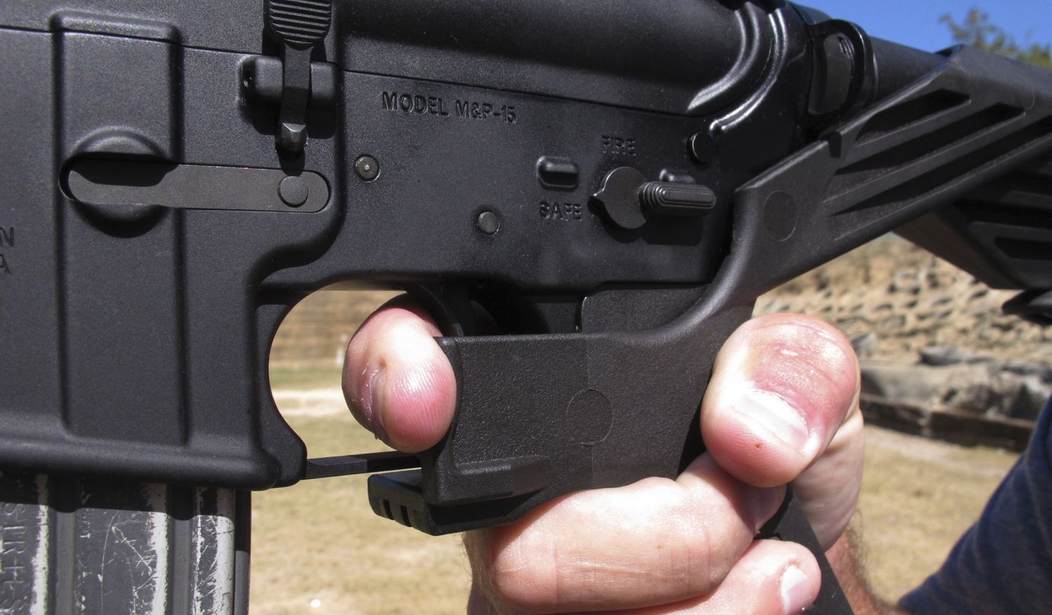Questions asked by Supreme Court justices Wednesday indicated that the ATF's ban on bump stocks will probably not survive.
While justices agreed that the government had the authority to ban bump stocks and that they functioned in a way that duplicated the performance covered in the 1934 Firearms Act that limited possession of fully automatic weapons, the six conservative justices seemed inclined to strike down the ATF rule because bump stocks do not function in the way specified in the law and because the government admitted that anyone possessing a bump stock purchased before the ATF rule or after a circuit court decision striking down the rule could be prosecuted.
The ban on bump stocks went into effect after Stephen Paddock opened fire on a crowd of concert-goers on the Las Vegas Strip in 2017. He killed 60 people and wounded over 400. His motive remains unknown and seems to invoke no curiosity. Trump caved to public pressure and ordered Attorney General Jeff Sessions to regulate the previously legal items.
Trump's memorandum to Sessions directs the Department of Justice to "dedicate all available resources" to completing a review of more than 100,000 comments it received from December through January on a notice of a proposed rulemaking. Trump directed the department to, "as expeditiously as possible," propose for notice and comment "a rule banning all devices that turn legal weapons into machine guns."
This action reversed 2003 and 2010 determinations by the ATF that a bump stock did not convert a semi-automatic rifle into a machinegun and was, therefore, legal.
The rule was challenged and overturned by the Fifth Circuit, bringing us to yesterday's Supreme Court action. Keep in mind that this case was not argued as a Second Amendment case. This case attacks the rule based on the theory that a) bump stocks had been legal for over a decade before being made illegal, and b) the ATF rule regulates the device using an inapplicable law.
Bump Stock Ban Overturned by the Fifth Circuit Setting up a Supreme Court Battle
Trump's Bump Stock Ban to Face Supreme Court Scrutiny
There was a lot of confusion, even among the lawyers arguing the case, about how a bump stock works. None of their confusion reached the epic level of Justice Ketanji Brown Jackson when she claimed a bump stock increased the rate of fire to 800 rounds per second.
Justice Jackson's Comment About Bump Stocks Just May Be the Most Ignorant Thing You've Ever Heard
The two sides in the case formed pretty quickly. The three liberal members didn't see a problem with the ATF regulation because it accomplished the purpose of the 1934 Firearms Act.
Liberal Justice Ketanji Brown Jackson, in contrast, said bump stocks are “the kind of weapons that Congress was intending to prohibit because of the damage they cause.” Justice Elena Kagan, also a liberal, said the “torrent of bullets” fired by rifles equipped with the devices is “in the heartland” of what lawmakers were concerned about when they passed the statute.
The six conservatives focused on three main areas.
First, the 1934 law defines a machine gun as “any weapon which shoots, is designed to shoot, or can be readily restored to shoot, automatically more than one shot, without manual reloading, by a single function of the trigger.” The bump stock requires the trigger to function with each round fired, so it doesn't meet the definition in the law.
However, results-oriented jurisprudence was on display. Coming off her "800 rounds per second" comment, Justice Jackson offered more wisdom.
Justice Ketanji Brown Jackson similarly posited that the category of firearms prohibited by the ban on machine guns was based on “the high rate of fire as opposed to … the movement of the trigger.” But if you are correct, she said to Mitchell, “why would Congress want to prohibit certain things based on whether the trigger is moving as opposed to certain things that can achieve this … lethal kind of spray of bullets?”
Kagan fell into this camp.
Kagan was perhaps the strongest proponent of this argument. She acknowledged that courts should interpret statutes by “reading them” – an approach known as textualism. But, she told Mitchell, “textualism is not inconsistent with common sense.” And common sense, she said, leads to the conclusion that the statute is intended to cover “a weapon that fires a multitude of shots with a single human action. Whether it’s a continuous pressure on a conventional machinegun, holding the trigger, or a continuous pressure on one of these devices on the barrel, I can’t understand how anybody could think that those two things should be treated differently.”
Under this theory, the 1934 Firearms Act could probably be bootstrapped into turning speeding into a federal offense.
Even justices who agreed the government could regulate bump stocks were troubled by how the ATF arrived at its decision.
Justice Barrett gets at the crux: “Look, intuitively, I am entirely sympathetic to your argument and it seems like ‘yes, this is functioning like a machine gun would.’” But she said the question was why Congress hadn't made the legislation cover it more clearly.
Justice Gorsuch said he could “certainly understand why these items should be made illegal” but suggested it would be up to lawmakers to do so explicitly.
“Maybe they should have written something better. One might hope they might write something better in the future. But that’s the language we’re stuck with,” Gorsuch said, taking issue with the government’s reading of the text to include bump stocks.
Second, the ATF had on two occasions declared bump stocks to be legal. The decision to regulate them after at least 520,000 of them have been sold doesn't seem workable.
Third, some of the justices seem to realize the war the Department of Justice under Biden has carried out against Americans who don't go along with every rule the DOJ or some other agency comes up with.
Justice Neil Gorsuch was the first to flag this concern. He told [Deputy U.S. Solicitor General Brian] Fletcher that he could “certainly understand why these items should be made illegal,” but he observed that before 2018 the ATF had repeatedly indicated that bump stocks are not machine guns. As a result of the agency’s about-face in 2018, Gorsuch complained, somewhere between 250,000 and 500,000 people could be convicted of felonies, which could lead not only to jail time but also the loss of other civil rights, including the right to vote.
Fletcher pushed back, responding that in the wake of the Las Vegas shooting it “would have been irresponsible for the ATF not to” revisit its earlier interpretation of the definition of machine gun, and to revise it if it concluded that it was incorrect.
The key exchange is below.
Justice Brett Kavanaugh picked up on Gorsuch’s questions a few minutes later. Could someone be convicted, he asked, even if he wasn’t aware that bump stocks are now prohibited? When Fletcher’s answer was yes, Kavanaugh shot back, “That’s going to ensnare a lot of people.”
Justice Samuel Alito worried aloud about bump-stock owners who had the devices between the 2018 rule and the decision by the 5th Circuit holding that the rule is invalid. Alito characterized Fletcher’s response – that they too could be held criminally liable – as “disturbing.”
Our Bearing Arms colleague, Cam Edwards, gives his view of the action in this video: Let’s Talk About What Happened at the Supreme Court Today.
From the arguments, it seems that the ATF bump stock rule will lose by 6-3, and the main reason for that decision will be that the bump stock is not covered by the definition of a machinegun established in the 1934 Firearms Act.














Join the conversation as a VIP Member